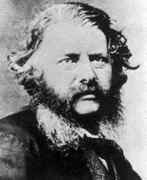◀ ▲ ▶History / 19th-century / Person: Rankine, William John Macquorn
Person: Rankine, William John Macquorn

William Rankine worked on several areas of applied mathematics including mechanics, thermodynamics and waves.
Mathematical Profile (Excerpt):
- Rankine's interests were divided between music and mathematics.
- For two years from 1836 to 1838 Rankine studied at the University of Edinburgh, attending a wide range of lectures in science subjects, but choosing not to attend mathematics classes.
- From 1839 to 1841 Rankine worked on numerous projects that John Benjamin MacNeill was involved with, including river improvements, waterworks, railways and both harbours.
- Some of the work took Rankine to Ireland.
- Further papers read to the Institution of Civil Engineers were highly thought of and several won Rankine prizes.
- Rankine was appointed to the regius chair of civil engineering and mechanics at Glasgow in 1855.
- Rankine's study of the applications of mathematics began quite early in his career as an engineer.
- Both Rankine and Clausius approached the second law of thermodynamics from the point of view of the transformation from one kind of energy to the other.
- But whereas Clausius considered the conversion between heat and work and the flow of heat from high to low temperature in a cyclic process, Rankine concentrated on the change from kinetic (molecular) to potential energies, and related this change to heat flow by use of his "heat-potential" function.
- Rankine's work was extended by Maxwell.
- Rankine also wrote on fatigue in the metal of railway axles, on earth pressures in soil mechanics, and the stability of walls.
- Rankine's health deteriorated rapidly during the final six months of his life.
Born 5 July 1820, Edinburgh, Scotland. Died 24 December 1872, Glasgow, Scotland.
View full biography at MacTutor
Tags relevant for this person:
Astronomy, Geography, Origin Scotland, Physics
Thank you to the contributors under CC BY-SA 4.0! 

- Github:
-

- non-Github:
- @J-J-O'Connor
- @E-F-Robertson
References
Adapted from other CC BY-SA 4.0 Sources:
- O’Connor, John J; Robertson, Edmund F: MacTutor History of Mathematics Archive
